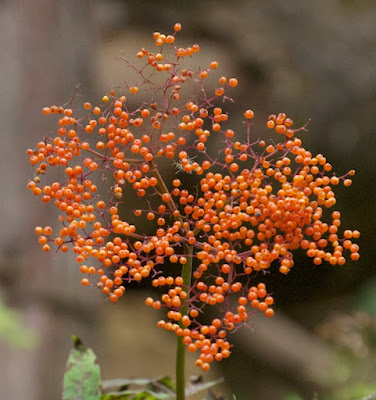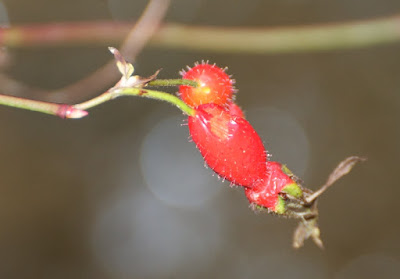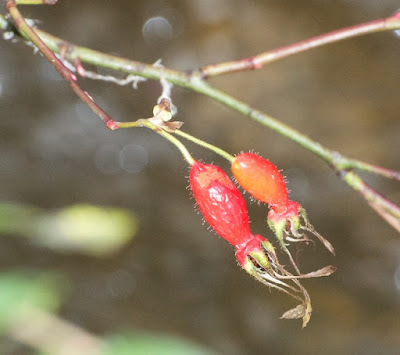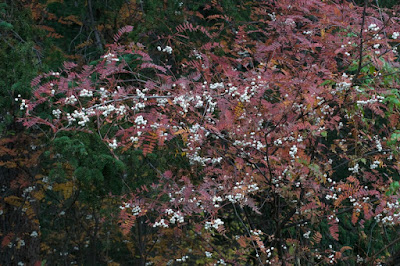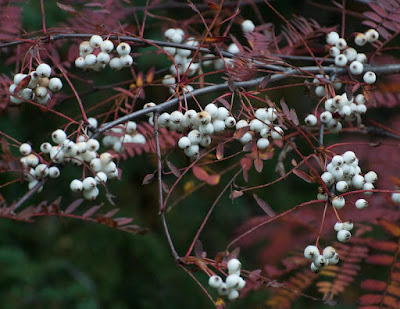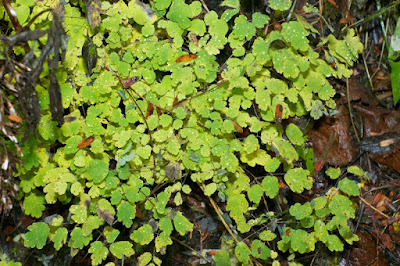Just driving in to the area was enough to show us that we were entering something quite different from the stony valley we had been following from the lowlands of Chengdu: green-clad, forested mountains, undoubtedly full of all sorts of interesting things to keep a naturalist happy.
I was rather taken with the intricate wooden facade of the government building at the park entrance.
The park itself protects a world of rushing waters and densely vegetated, biodiverse temperate woodlands.
To get to the falls themselves, we descended a flight of wooden stairs through the forest. In spring, I would have expected to be serenaded by a host of Sichuanese birds as we went along, but in October the trees were silent. In our whole time there I did not hear or see a single bird.
The forest, however, was worth seeing even without birds or other animal life. I had to deal with my usual, frustrating botanical ignorance. These lovely cinnamon-barked trees, though, are (if my web searches have not failed me) Chinese Red Birch (Betula utilis ssp. albosinensis), a form of the widespread, white-barked Himalayan White Birch (B. utilis). It's amazing what you can learn from the internet.
As in other birches, the bark of Chinese Red Birch peels away in sheets from the trunk creating a frilly, origami-like patchwork.
We were, it seemed, too early for the show of fall colour that makes this part of China such a tourist draw in autumn. Only a few trees were beginning to show, including these (some sort of locust, or sumac? Anybody?).
The full glory of fall colour in China, as in the other great showplace for autumn leaves, eastern North America, is the gift of an abundance of maples. In most other deciduous trees the colours revealed when the chlorophyll fades are those that were there before - carotenoids, which are mostly yellow - but in the sugar in maple leaves produces the newly-formed anthocyanins responsible for their rich reds, oranges and purples. For these leaves, which I believe belong to Acer caesium, the process still has some way to go.
Botanizing can slow you down. Here you can see Eileen waving at me from the platform, and wondering why it is taking me so long to descend the staircase.
Nonetheless, I finally made it to the viewing platform and joined the others for a view of the falls. Zhaga, by the way, is no ordinary cascade. According to the Munigou Valley website, it belongs to a rather rare category, the tufa waterfall. In fact the government website claims it is the biggest tufa waterfall in the world, though it is only 104 metres tall and the second-highest tufa waterfall is supposed to be the 200-m. Kadishi Waterfall in South Africa. The tallest may be the 320-m Anisakan Falls in Myanmar.
Anyway, according to one definition, "A tufa waterfall is formed when water running over dolomite rock absorbs calcium. Mosses which grow on the rocks in the stream extract carbon dioxide during photosynthesis which precipitates the calcium from the water to deposit it as layers of tufa on the surface of the waterfall – a process that takes millions of years. The waterfall continue to flow underneath this rock-hard outer shell."
The deposits here, in fact, are not, strictly speaking, tufa, but travertine (though the terms overlap), deposited by mildly thermal springs. They have built up into a series of miniature dams and terraces, sending the water from the falls spilling over into the adjacent forest. This is where the world record comes in - at 3.6 kilometres in extent, these may at least be the most extensive series of travertine terraces in the world. Anyway, that's Eileen in the centre photo, posing with our friend Mui Ling.
On the way back to our bus I had a chance to do a bit more botanizing. This time I paid more attention to the shrubs and understorey plants. These spectacular umbels of shiny orange berries, surmounting compound leaves already beginning to wilt and fade, appear to belong to the Asian Dwarf Elder (Sambucus adnata). It is one of only a few species of elder that is an entirely herbaceous plant, sending up new shoots each year, rather than a woody shrub.
There were woody elders here too (well. I think that is what they were), with their own clusters of orange berries. This is, I presume, the North China Red Elder (Sambucus williamsii).
Even more colourful were these brilliant little rosehips, perhaps the fruits of Mandarin or Moyes Rose (Rosa moyesii) though with the number of wild roses native to Sichuan I cannot really be sure.
These may be the same; they were everywhere, and made up to some degree for the autumn colours that we were too early to see.
The woods must be spectacular in the flowering season!
That is not to say that there was no autumn colour at all. The leaves of the mountan ash trees (Sorbus sp.), or rowans as they call them in England, were already a deep purplish red , set off (in this species, which may well be S. kohneana) by clusters of white berries.
This being China, of course, bamboos (of a variety of species) were a major component of the undergrowth vegetation.
So were ferns, of a variety of shapes and sizes(some of which, like the clump in the upper photograph, look quite unfernlike).
The delicate fronds of maidenhair fern (Adiantum sp.) decorated the forest floor here, as they do in humid woodlands over much of the world.
This rather unlovely object is, I believe, a liverwort, a relative of mosses.
Strands of Usnea lichen hung from the trees; I wonder if any bird uses them as nest sites, as the Northern Parula Warbler (Setophaga americana) does in Canada? In China, birds may not use Usnea but people do; in traditional Chinese medicine, it is valued as the source of a natural antibiotic.
At this point I am afraid that my botanical information runs dry. I have no idea what any of the next few plants are; I hope you will enjoy them anyway...
....and if you do recognize them, please tell me!
By now, it was late in the day, and time to head on to Jiuzhaigou. Our bus carried us, tantalizingly, past stunning mountain peaks undoubtedly full of rare wildlife - but for this trip, I could only watch them gleam in the setting sun.
We were, it seemed, too early for the show of fall colour that makes this part of China such a tourist draw in autumn. Only a few trees were beginning to show, including these (some sort of locust, or sumac? Anybody?).
The full glory of fall colour in China, as in the other great showplace for autumn leaves, eastern North America, is the gift of an abundance of maples. In most other deciduous trees the colours revealed when the chlorophyll fades are those that were there before - carotenoids, which are mostly yellow - but in the sugar in maple leaves produces the newly-formed anthocyanins responsible for their rich reds, oranges and purples. For these leaves, which I believe belong to Acer caesium, the process still has some way to go.
Botanizing can slow you down. Here you can see Eileen waving at me from the platform, and wondering why it is taking me so long to descend the staircase.
Nonetheless, I finally made it to the viewing platform and joined the others for a view of the falls. Zhaga, by the way, is no ordinary cascade. According to the Munigou Valley website, it belongs to a rather rare category, the tufa waterfall. In fact the government website claims it is the biggest tufa waterfall in the world, though it is only 104 metres tall and the second-highest tufa waterfall is supposed to be the 200-m. Kadishi Waterfall in South Africa. The tallest may be the 320-m Anisakan Falls in Myanmar.
Anyway, according to one definition, "A tufa waterfall is formed when water running over dolomite rock absorbs calcium. Mosses which grow on the rocks in the stream extract carbon dioxide during photosynthesis which precipitates the calcium from the water to deposit it as layers of tufa on the surface of the waterfall – a process that takes millions of years. The waterfall continue to flow underneath this rock-hard outer shell."
The deposits here, in fact, are not, strictly speaking, tufa, but travertine (though the terms overlap), deposited by mildly thermal springs. They have built up into a series of miniature dams and terraces, sending the water from the falls spilling over into the adjacent forest. This is where the world record comes in - at 3.6 kilometres in extent, these may at least be the most extensive series of travertine terraces in the world. Anyway, that's Eileen in the centre photo, posing with our friend Mui Ling.
On the way back to our bus I had a chance to do a bit more botanizing. This time I paid more attention to the shrubs and understorey plants. These spectacular umbels of shiny orange berries, surmounting compound leaves already beginning to wilt and fade, appear to belong to the Asian Dwarf Elder (Sambucus adnata). It is one of only a few species of elder that is an entirely herbaceous plant, sending up new shoots each year, rather than a woody shrub.
There were woody elders here too (well. I think that is what they were), with their own clusters of orange berries. This is, I presume, the North China Red Elder (Sambucus williamsii).
Even more colourful were these brilliant little rosehips, perhaps the fruits of Mandarin or Moyes Rose (Rosa moyesii) though with the number of wild roses native to Sichuan I cannot really be sure.
These may be the same; they were everywhere, and made up to some degree for the autumn colours that we were too early to see.
The woods must be spectacular in the flowering season!
That is not to say that there was no autumn colour at all. The leaves of the mountan ash trees (Sorbus sp.), or rowans as they call them in England, were already a deep purplish red , set off (in this species, which may well be S. kohneana) by clusters of white berries.
This being China, of course, bamboos (of a variety of species) were a major component of the undergrowth vegetation.
So were ferns, of a variety of shapes and sizes(some of which, like the clump in the upper photograph, look quite unfernlike).
The delicate fronds of maidenhair fern (Adiantum sp.) decorated the forest floor here, as they do in humid woodlands over much of the world.
This rather unlovely object is, I believe, a liverwort, a relative of mosses.
Strands of Usnea lichen hung from the trees; I wonder if any bird uses them as nest sites, as the Northern Parula Warbler (Setophaga americana) does in Canada? In China, birds may not use Usnea but people do; in traditional Chinese medicine, it is valued as the source of a natural antibiotic.
At this point I am afraid that my botanical information runs dry. I have no idea what any of the next few plants are; I hope you will enjoy them anyway...
....and if you do recognize them, please tell me!
By now, it was late in the day, and time to head on to Jiuzhaigou. Our bus carried us, tantalizingly, past stunning mountain peaks undoubtedly full of rare wildlife - but for this trip, I could only watch them gleam in the setting sun.

























